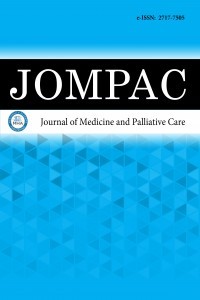COVID-19 hastalarında uzamış D-dimer yüksekliği ve herediter trombofili arasındaki ilişki
COVID-19, hereiditer trombofili, D-dimer
The relationship between extended D-dimer elevations and hereditary thrombophilia in COVID-19 patients
COVID-19, Heredidary thrombophilia, D-dimer,
___
- Kimball A, Hatfield KM, Arons M, et al. Asymptomatic and presymptomatic SARS-CoV-2 infections in residents of a long-term care skilled nursing facility - king county, Washington, MMWR Morb Mortal Wkly Rep 2020; 69: 377–81.
- World Health Organizatiron. WHO Coronavirus (COVID-19) Dashboard. Available online: https://COVID19.who.int/ (last acces 04/06/2022)
- Khan SS. The Central Role of PAI-1 in COVID-19: Thrombosis and beyond Am J Respir Cell Mol Biol 2021; 65: 238-40.
- Fraisse M, Logre E, Pajot O, Mentec H, Plantefeve G, Contou D. Thrombotic and hemorrhagic events in critically ill COVID-19 patients: a French monocenter retrospective study. Critical Care (London, England) 2020; 24: 275
- Al-Samkari H, Karp Leaf RS, Dzik WH, et al. COVID-19 and coagulation: bleeding and thrombotic manifestations of SARS-CoV-2 infection. Blood 2020; 136: 489–500.
- Cui S, Chen S, Li X, Liu S, Wang F. Prevalence of venous thromboembolism in patients with severe novel coronavirus pneumonia. J Thromb Haemost 2020; 18: 1421–4.
- Kashi M, Jacquin A, Dakhil B et al. Severe arterial thrombosis associated with COVID-19 infection. Thromb Res 2020; 192: 75–7.
- Labo N, Ohnuki H, Tosato G. Vasculopathy and coagulopathy associated with SARS-CoV-2 infection. Cells 2020; 9: 1583.
- Nauka PC, Oran E, Chekuri S. Deep venous thrombosis in a non-critically ill patient with novel COVID-19 infection. Thromb Res 2020; 192: 27–8.
- Gaffney PJ. Breakdown products of fibrin and fibrinogen: molecular mechanisms and clinical implications. J Clin Pathol 1980; 14: 10–7.
- Velavan TP, Meyer CG. Mild versus severe COVID-19: laboratory markers. Int J Infect Dis 2020; 95: 304–7.
- Lippi G, Plebani M. Laboratory abnormalities in patients with COVID-19 infection. Clin Chem Lab Med 2020; 58: 1131- 4.
- Iba T, Levy JH, Levi M, et al. Coagulopathy of coronavirus disease 2019. Crit Care Med 2020; 48: 1358–64.
- Huang C, Wang Y, Li X, Ren L, et al. Clinical features of patients infected with 2019 novel coronavirus in Wuhan, China. Lancet 2020; 395: 497–06.
- Rostami M, Mansouritorghabeh H. D-dimer level in COVID-19 infection: a systematic review. Expert Rev Hematol 2020 ;13: 1265-75.
- Harper PL, Theakston E, Ahmed J, Ockelford P. D-dimer concentration increases with age reducing the clinical value of the D-dimer assay in the elderly. Intern Med J 2007; 37: 607-13.
- Velavan TP, Meyer CG. Mild versus severe COVID-19: laboratory markers. Int J Infec Dis 2020; 95: 304–7.
- Oualim S, Abdeladim S, Ouarradi A, et al. Elevated levels of D-dimer in patients with COVID-19: prognosis value. Pan African Med J 2020; 35: 105.
- Zhang L, Yan X, Fan Q, et al. D-dimer levels on admission to predict in hospital mortality in patients with COVID-19. J Thromb Haemost 2020; 18: 1324-9.
- M, van der Poll T. Coagulation and sepsis. Thrombosis research 2017; 149: 38-44.
- Lapić I, Radić Antolic M, Horvat I, et al. Association of polymorphisms in genes encoding prothrombotic and cardiovascular risk factors with disease severity in COVID-19 patients: A pilot study. J Med Virol 2022; 94: 3669-75.
- Ponti G, Pastorino L, Manfredini M, et al. COVID-19 spreading across world correlates with C677T allele of the methylenetetrahydrofolate reductase gene prevalence. J Clin Lab Anal 2021; 35: 23798.
- Cao JI, Chen X, Jiang LI, et al. DJ‐1 suppresses ferroptosis through preserving the activity of S‐adenosyl homocysteine hydrolase. Nat Commun 2020; 11: 1251.
- Başlangıç: 2020
- Yayıncı: MediHealth Academy Yayıncılık
Davut SAKIZ, Murat ÇALAPKULU, Muhammed Erkam SENCAR, Bekir UCAN, İlknur ÖZTÜRK ÜNSAL, Mustafa ÖZBEK, Erman ÇAKAL
Hale ATEŞ, Kurtuluş AKSU, İlkay KOCA KALKAN, Musa TOPEL, Senay DEMİR, Selma YESİLKAYA, Sakine NAZİK BAHCECİOGLU
Arif Cengiz GÜLTEKİN, Ercan TÜRKMEN, Ferah TARAN, Melda DİLEK, Hayriye SAYARLİOGLU, Nurol ARIK
Melih HANGÜL, Mehmet KÖSE, Hüseyin PÜR, Murat DOĞAN, Emrah TÜRK, Ali ERSOY, Mehmet Adnan ÖZTÜRK
Asena AYAR MADENLİ, İnci ÖZ, Tuğba GÜRBÜZ
Gülçin TÜRKMEN SARIYILDIZ, Mehmet Emin DEMİR, Zafer ERCAN, Ulaş SÖZENER, Canan ÇİÇEK, Aykut İlker ARSLAN, Fatma Necla ÖZŞEKER
Bethesda IV-V tiroid nodüllerinin değerlendirilmesi: klinik deneyim
Salih CELEPLİ, İrem BİGAT, Baki TÜRKOĞLU, Mustafa TANRISEVEN, Pınar CELEPLİ, Levent DONMEZ
Ezgi EREM, Fatih Mehmet KIŞLAL
PCO2, COVID-19 hastalarında mortalite belirteci olabilir mi?
